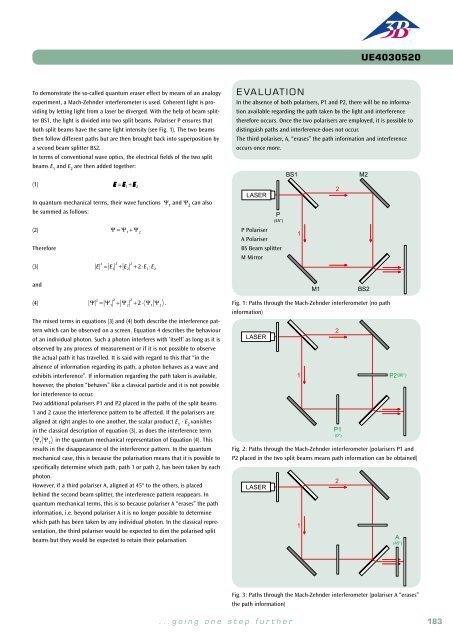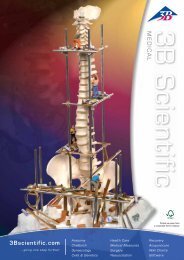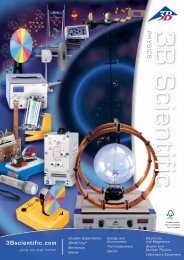3B Scientific - Physics & Engineering Experiments
3B Scientific - Physics & Engineering Experiments
3B Scientific - Physics & Engineering Experiments
Create successful ePaper yourself
Turn your PDF publications into a flip-book with our unique Google optimized e-Paper software.
UE4040100<br />
Optics / Polarisation<br />
Malus’ law<br />
UE4040100<br />
basic PRINCIPLES<br />
Light, being a transverse wave, can be polarised, for example by allowing<br />
it to pass through a polarising filter. In a linearly polarised light<br />
wave, both the electric field E and magnetic field B oscillate in distinct<br />
planes. The orientation direction of the electric field oscillation is called<br />
the polarisation direction.<br />
In this experiment light passes through two filters termed the polariser<br />
and the analyser, which are aligned at an angle of ϕ to one another. The<br />
polariser only allows one linearly polarised component of the light to pass<br />
through it. The electric field of this component may be deemed to have an<br />
amplitude E 0<br />
.<br />
The amplitude of the component after passing through the analyser filter is<br />
given by<br />
(1)<br />
E = E 0<br />
⋅cosϕ<br />
This is a measure of the amount of light which can pass through the analyser.<br />
The intensity of the light corresponds to the square of the electric field<br />
strength. The intensity of light beyond the analyser is therefore as follows:<br />
(2) I = I 0<br />
⋅cos 2 ϕ ,<br />
where I 0<br />
is the intensity of light after passing through the polariser.<br />
Equation (2) is a statement of Malus’ law. This will be verified in the experiment<br />
by measuring the light intensity using a light sensor. In this experiment,<br />
the intensity of light measured for an angle ϕ = 90° should be equal<br />
to that of the ambient light. This value should be subtracted from all the<br />
other intensity measurements.<br />
EVALUATION<br />
Once the ambient light intensity has been subtracted from all the measurements,<br />
they are then plotted as a function of ϕ. The curve should<br />
then be described by equation (2).<br />
Intensity I is then plotted in another graph as a function of cos²ϕ. In this<br />
case, the measurements lie on a straight line through the origin which<br />
has a gradient I 0<br />
.<br />
I / lux<br />
4<br />
3<br />
2<br />
1<br />
E X PERIMEN T<br />
PROCEDURE<br />
• Measure the intensity of light I transmitted<br />
through a polarising filter as a<br />
function of the angle of rotation of the<br />
filter.<br />
• Verify Malus’ law.<br />
OBJECTIVE<br />
Verify Malus’ law for linearly polarised light<br />
SUMMARY<br />
Malus’ law describes how intensity I of polarised light with an initial intensity I 0<br />
, having passed through<br />
an analyser filter, depends on the angle of rotation of the filter. The intensity of the light is measured<br />
using a light sensor.<br />
B<br />
E<br />
Fig. 1: Illustration showing the definition for direction of polarisation<br />
k<br />
0<br />
0° 90° 180° 270° 360°<br />
<br />
Fig. 3: Light intensity I as a function of the angle ϕ between the polariser<br />
and the analyser<br />
I / lux<br />
4<br />
Required Apparatus<br />
A<br />
3<br />
Quantity Description Number<br />
1 Optical Precision Bench D, 50 cm 1002630<br />
2<br />
4 Optical Rider D, 90/50 1002635<br />
1 Optical Lamp, Halogen 1003188<br />
1 Transformer 12 V, 60 VA (115 V, 50/60 Hz) 1006780 or<br />
E cosϕ<br />
0<br />
1<br />
Transformer 12 V, 60 VA (230 V, 50/60 Hz) 1000593<br />
1<br />
2 Polarisation Filter on Stem 1008668<br />
1 Light Sensor 1000562<br />
1 <strong>3B</strong> NETlog (230 V, 50/60 Hz) 1000540 or<br />
ϕ<br />
E 0<br />
P<br />
0<br />
0 1<br />
2<br />
cos <br />
<strong>3B</strong> NETlog (115 V, 50/60 Hz) 1000539<br />
Fig. 2: Illustration of how the electric field beyond the analyser is calculated<br />
Fig. 4: Light intensity I as a function of cos²ϕ<br />
184<br />
<strong>3B</strong> <strong>Scientific</strong>® <strong>Experiments</strong><br />
...going one step further 185















